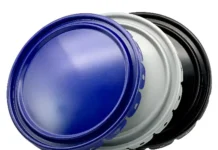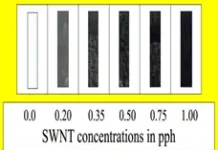 By Liz Stevens, writer, UV+EB Technology
By Liz Stevens, writer, UV+EB Technology
The RadTech 2023 RadLaunch Awards included a Special University Award that was presented to Dr. Vijay Mannari, director of the Coating Research Institute of Eastern Michigan University, Ypsilanti, Michigan. Dr. Mannari earned the award for his group’s research and development of sustainable polymeric materials and processes for advanced coatings. “Guided by the principles of green chemistry and engineering,” said Mannari, “our research group is combining strengths of bio-renewable materials, efficient cross-linking chemistries and novel processing techniques for developing a platform for sustainable materials that will advance UV-cure technology and enhance the sustainability of industrial products.”
Mannari’s group has broken new ground by developing novel, sustainable bio-renewable-derived UV oligomers and hybrids of organic and inorganic polymeric materials. “The organic-inorganic hybrids (OIH) are unique and valuable,” Mannari explained, “because they combine the benefits of both organic and inorganic components, such as the flexibility, toughness, compatibility and superior adhesion of organic components, while also tapping the inertness, chemical resistance and hardness of inorganic structures.” Working with hybrids offers the possibility of tailoring the properties of coatings by varying the organic/inorganic compositions and the structures at the micro or nano scales. Bio-renewable-derived UV oligomers can be designed and synthesized based on resources such as plant oils, fatty acid esters and sugars. “These oligomers,” said Mannari, “are functionalized with such functional groups as acrylate, epoxy, alkoxysilane and acetoacetate to enable them to cure by different cure mechanisms, such as cationic, free-radical, sol-gel and often combinations of these mechanisms.” Mannari offered an example of a hybrid with a cross-linked polymer matrix that contains uniformly distributed organic and inorganic domains. “In our bio-based OIH coatings, for instance, soybean oil (fatty acid) structure provides the organic domain while silica structure (derived from alkoxysilane during curing) forms the inorganic domain. The beauty of OIH materials is our ability to vary the relative proportions of organic and inorganic domains to manipulate film properties.”
The water-based and UV-curable polyurethane dispersions developed by the Coating Research Institute group are superior to their standard counterparts. “The conventional 100% solid UV-cure systems typically are based on acrylate functional oligomers, diluted with acrylic monomers (aka reactive diluents), with added photo initiators, and optionally with added pigments,” Mannari said. An inherent limitation of the conventional UV-cure systems is the use of acrylate monomers required to control viscosity and application properties. “These monomers,” said Mannari, “not only pose health and environmental issues but also affect characteristics such as cure-extent, oxygen inhibition issues at the surface and film shrinkage. UV-curable water-based PU dispersions (UV-PUDs) have the potential to avoid the use of monomers completely, and hence the associated issues.” In addition, polyurethane chemistry offers outstanding performance, leading to UV-PUDs rapidly gaining market acceptance. Mannari’s research group has also developed and patented UV-PUDs with high bio-based content, enhancing their environmental sustainability profile. (US Patent 8.952.093, 2015)
Mannari and the Institute have implemented dual-cure systems using click-based chemistry to process coatings. Dual curing combines two different, compatible polymerization reactions that can occur simultaneously or sequentially. In some cases, sequential dual curing can be used to kick off an initial cure phase so that the treated material has cured enough to be handled, followed by a second curing stage that completes the cross-linking. Dual curing also overcomes one of the inherent disadvantages of UV curing. “One of the major limitations of UV-cure coatings,” Mannari explained, “is the line-of-sight requirement. UV must reach the entire surface of a coating for the cure to be complete. This poses difficulties in applying and curing coatings on 3D objects with complex geometries.” In three-dimensional objects, there often are areas hidden from the direct path of the UV – called shadow areas – where curing cannot occur. “That,” said Mannari, “is where dual-curing systems become important. In typical dual-curing systems, there are two modes of curing – one mechanism requires UV exposure to cure, while a second mechanism is independent of UV exposure. This allows good curing even in the shadow areas.” Scientists and engineers have identified several secondary cure chemistries and combined them with UV curing to achieve successful dual-cure systems. Some commercially available technology combines free-radical initiated cross-linking (UV-initiated) with condensation cross-linking (in which no UV is required). The research group at Eastern Michigan University has developed some dual-cure systems that use ambient moisture for the secondary non-UV curing step.
The group’s work has effectively leveraged some click-chemistry’s rapid-curing potential and unique advantages. “By far the most dominant commercial UV-cure systems are based on acrylate-based materials that cure by free-radical polymerization mechanism,” Mannari stated. “These materials and their cure mechanism bring with them some inherent limitations. For example, oxygen inhibition (and hence poor curing) at and near the surface is a characteristic of coatings cured by free-radical mechanism.” Extremely rapid cure, while having some benefits, also leaves coatings with high shrinkage, resulting in poor adhesion and other film defects. Besides, some acrylic monomers have characteristic offensive odors and are skin irritants.
Some click reactions offer rapid curing via mechanisms other than free-radical polymerization, which can be advantageous. “Using advanced photoinitiators, such click reactions can be UV-initiated,” said Mannari. “As an example, we identified Michael-Addition (MA) click chemistry and sol-gel reaction to develop UV dual-cure systems. We meticulously designed dual-curable oligomers with Michael donor (Acetoacetate) moieties and alkoxysilane functional groups. The dual-cure coatings were formulated by combining these oligomers with acrylate oligomers as Michael acceptors and special photo-latent catalysts showed outstanding performance.” These coatings did not contain any acrylate monomers, VOCs or HAPs, and had balanced cure kinetics to afford defect-free OIH films. Mannari et al. recently were awarded a US patent 11912832 (2024) for this invention.
This dual-cure process only requires UV irradiation to kick off the two concomitant cure reactions. The two cure reactions proceed at different rates – with the primary reaction being very rapid (Michael-Addition) and the secondary reaction fairly slower (sol-gel reaction), resulting in a balanced curing. This offers users the advantage of increasing the production process’s flexibility. “The benefit of our technology,” said Mannari, “is that upon UV exposure, a catalyst is unblocked and has a long life (compared to the very short life of free radicals in conventional UV-curing). This enables the extension of the curing reaction even in the absence of a UV source.” After a short exposure to UV generates a stable base catalyst, the cure reaction can continue with ‘dark cure’ – via MA polymerization, anionic polymerization or silanol condensation – over time, without further UV exposure. “Dark cure allows not only more complete curing but also ensures uniformity of curing across the thickness of the film,” Mannari explained. “Furthermore, dark cure can continue to occur during the next processing stage, improving the efficiency and throughput of the process.”
Mannari and his group have developed several prototype systems on the organic-inorganic hybrid platform. “For the OIH systems,” he said, “we have taken two approaches for our development work: heavy-metal (specifically Cr(VI)-free) pretreatments and OIH coatings. We also have demonstrated their applications for robust 3D-printing materials and is a part of our US Patent 11,912,832 (Feb 2024).” Mannari et al. now are reaching out to industries to demonstrate the technology, especially the dual-cure UV-initiated work. “Next on our R&D list,” said Mannari, “is to find an industry or government partner to advance this technology for specific end-use applications and then to take the technology to Technology Readiness Level 5-6 level.”
For more information, visit www.emich.edu/cet/coatings-research-institute/.






